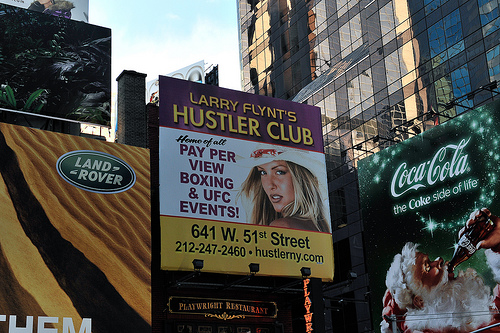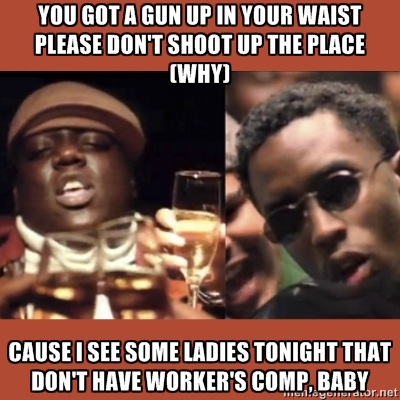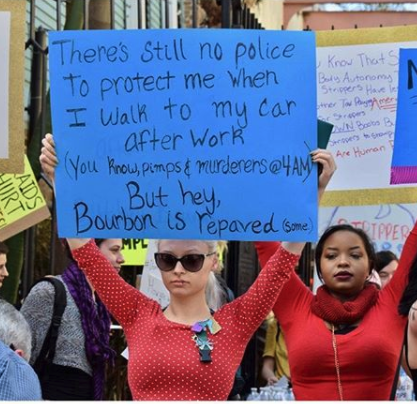Strippers
Buyer’s Remorse and Intoxication at the Strip Club

In the past few years there has been a rash of business men declining to pay their strip club credit card charges. For some unimaginable reason, a guy who racks up a $28,000 titty bar bill at New York’s Hustler Club doesn’t inspire a lot of sympathy. Are they victims of predatory vendors or are they morons with buyer’s remorse? Next to casinos, strip clubs are the businesses least likely to cut someone off as long as they are spending money. Of course, I’ve also known customers who take a pretty “law of the jungle” approach to their strip bar experiences—although usually for a few hundred to a couple thousand instead of $28K.
Journalists get too distracted by stripper-puns (“mammary mecca”? Really?) to provide us with a lot of facts, so I’m left with a few questions. What evidence does the club have that the customer knew what he was paying for? Did he sign for each round or only at the end of the night? How many drinks did he have? Did he have them all at the club? How drunk did he appear? And the obvious: Did he actually consume $28,000 in goods and services, or is that bill padded?
I Went To An Actual Vag Pageant

I feel nothing but pity for people who don’t “get” Twitter, anyone who has ever rejected me, and most of all, those who missed the 2nd Annual Vagina Beauty Pageant that happened this past week at Club Rouge in Portland, OR. I generally have a strong disdain for gimmicky strip club events and formal exotic dance pageants, but I feel like a child on Boxing Day now. I haven’t been able to get out of bed since realizing that I have to wait an entire year before I get to celebrate again.
I had considered entering when I read that the top vagina gets $500. I wasn’t sure what competing entailed, but felt like I had a solid entry. Plus, I thought maybe I could start charging extra for dances after I flashed customers my blue ribbon* (which I would carry on my person for the rest of my life, ready to show cops who pull me over for speeding, my future husband’s parents, etc). I boasted to a friend that I could win with toilet paper stuck to my junk, which I figure is the vaginal equivalent of doing a one-armed pushup. Ultimately, I was too confused (read: wimpy) to compete, but I did stop by to check it out just for the fresh blog material.
Today in Absolutely Horrible: SC Stripper Shot At Strip Club Denied Worker’s Comp
 The strippers at Tits and Sass have gone on record as being, in general, in favor of independent contractor status for strippers, because we like working at will, not having to be on a rigid schedule, having the ability to travel and work when the whim strikes, not turn over most of our money to the club, and taking Schedule C deductions. There have been a lot of lawsuits filed by strippers seeking to get paid back wages from clubs, and what usually happens is they are determined to be employees (because, honestly, most clubs do treat dancers like employees, mandating shift times and other controls over work), they get paid a small settlement, and the strippers still working at the club or clubs named in the suit inevitably wind up paying more to the club than they did before.
The strippers at Tits and Sass have gone on record as being, in general, in favor of independent contractor status for strippers, because we like working at will, not having to be on a rigid schedule, having the ability to travel and work when the whim strikes, not turn over most of our money to the club, and taking Schedule C deductions. There have been a lot of lawsuits filed by strippers seeking to get paid back wages from clubs, and what usually happens is they are determined to be employees (because, honestly, most clubs do treat dancers like employees, mandating shift times and other controls over work), they get paid a small settlement, and the strippers still working at the club or clubs named in the suit inevitably wind up paying more to the club than they did before.
However, the one time we’d actually WANT to see a court determine that a dancer had employee status, as, again, almost inevitably happens, the South Carolina Court of Appeals finds her to be an independent contractor. The reason she was seeking employee status? To collect worker’s compensation after she was SHOT IN THE CLUB in 2008. This is absolutely horrible.

